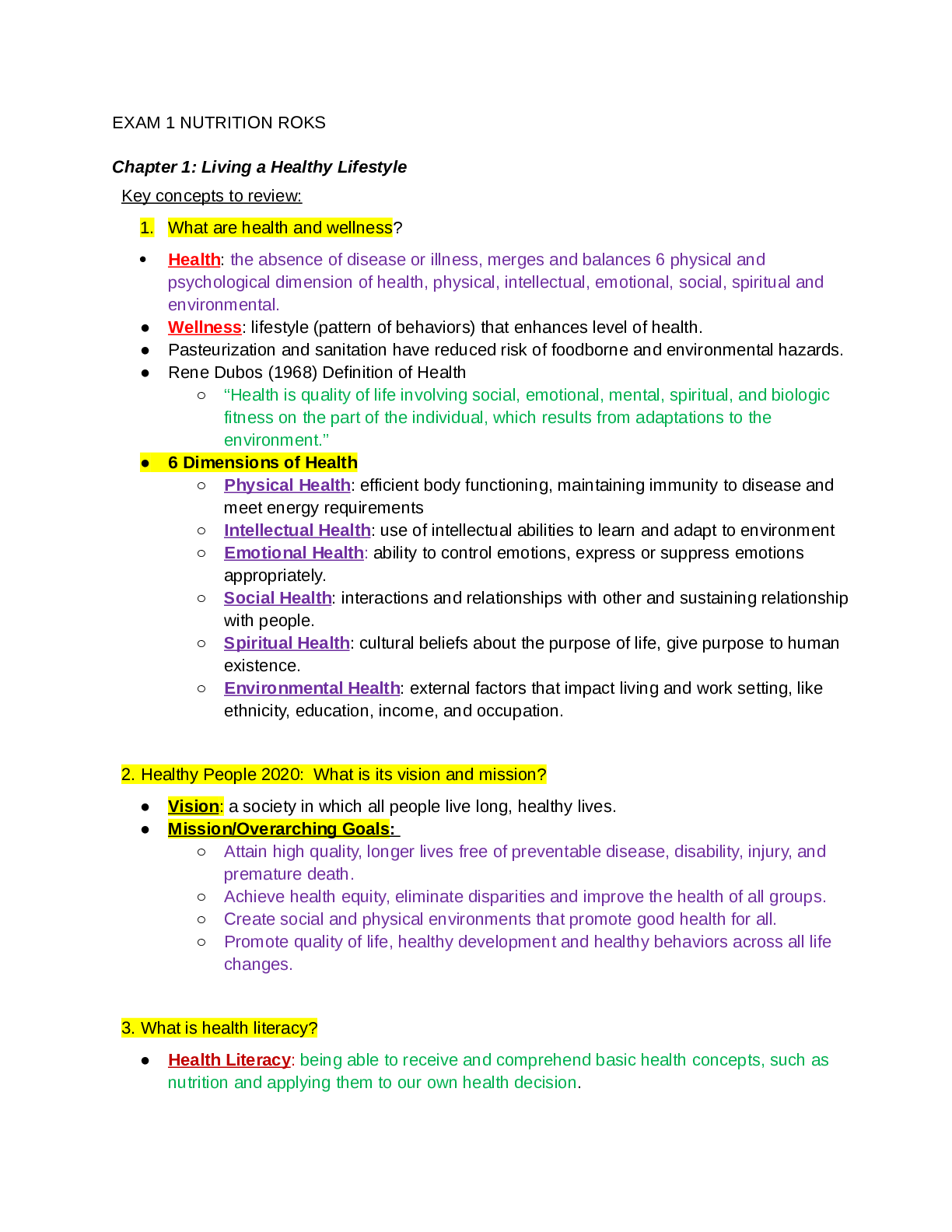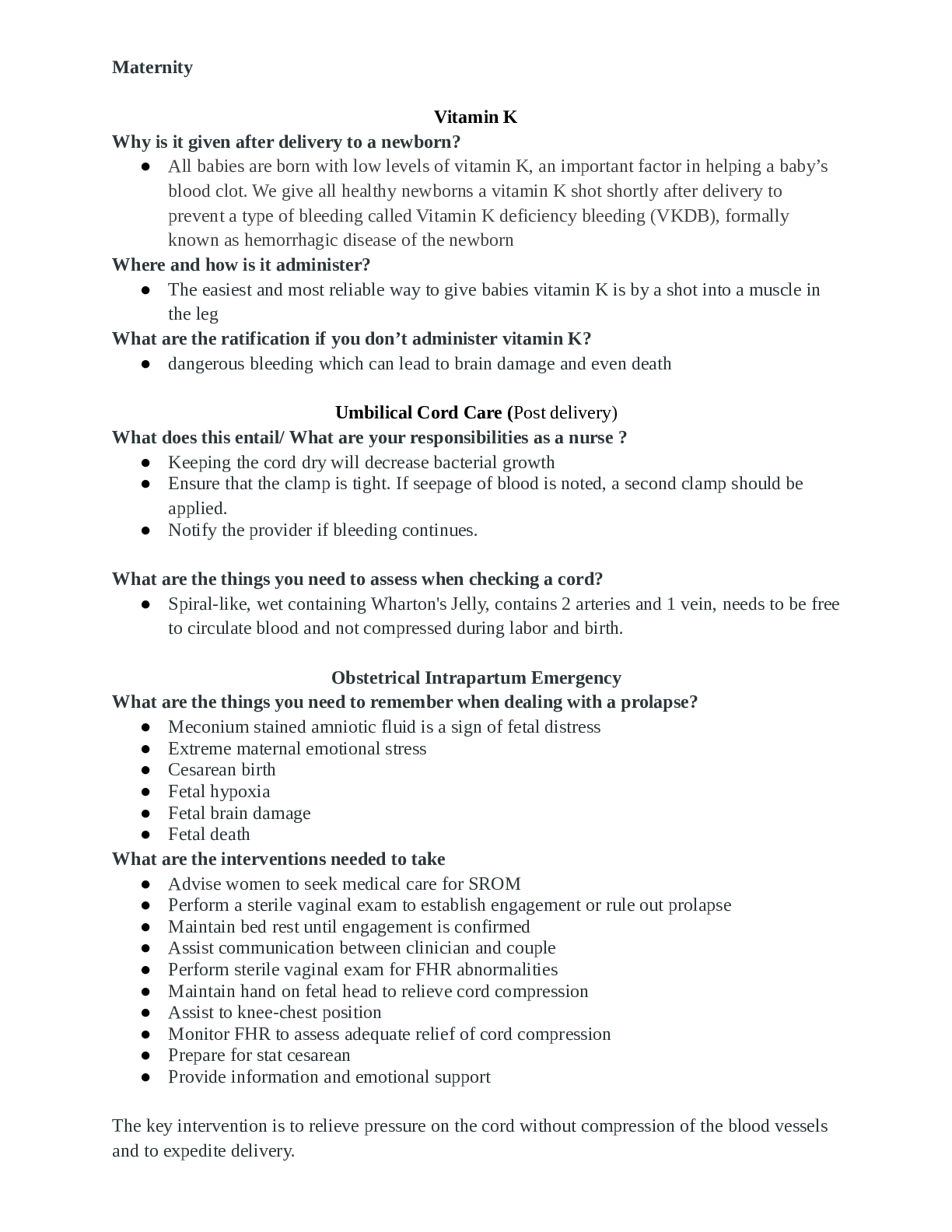*NURSING > STUDY GUIDE > NRSG 3302 (NRSG3302maternity study guide - LONG.) (NRSG 3302 (NRSG3302maternity study guide - LONG.) (All)
NRSG 3302 (NRSG3302maternity study guide - LONG.) (NRSG 3302 (NRSG3302maternity study guide - LONG.))
Document Content and Description Below
Maternal History • Obtain and interpret information relevant to newborn health including: • Maternal medical, nutritional, prenatal, obstetric, and intrapartal history • Social/Family histor... y • Results of maternal screening tests (e.g, Rh), rubella, hepatitis B and C, serology for syphilis, HIV, tuberculosis, illicit drugs, blood type, group B streptococcus, herpes simplex virus, gonorrhea, and chlamydia • Maternal medication use or substance use/abuse • Results of prenatal ultrasound testing Keep in mind: The babies review of systems (really mom’s medical history; prenatal care? Weight gain? Nutritional issues? Hx of frequent n/v? Did she keep her prenatal appointments? Obstetric history? Previous pregnancy/losses? Intrapartal history. Did the baby have repetitive variable decelerations? This can lead to hypoglycemia. Was there fetal tachycardia? May indicate sepsis How long was she in labor?What was the baby’s Apgar? Is it a traditional family? Is the mom going to be going back to work or staying home w/ baby?Mother’s GBS status. If positive, how many treatments of antibiotics did she receive prior to labor? Did baby grow at normal rate of speed? Babies are Smart • The healthy newborn is equipped to adjust to extrauterine life • The newborn is equipped at birth to survive, thrive and engage in social interaction. This is why babies will grab your hand and try to mimic you as the get older. The establishment of respirations is the most critical time of transition (from intra to extrauterine life). The change is initiated by the compression of the thorax, the lung expansion, increased alveoli oxygen concentration, and vasodilatation of the pulmonary vessels. Was it a vaginal birth or C-section? Mechanically the resp. system is stimulated to take it’s first breath. The biggest breath you ever take in your life is your first breath. Air will enter alveoli replacing the expelled amniotic fluid. Any fluids not initially expelled will be disbursed via the lymphatic system. The neonate starts to cry, changing the intrathoracic pressure, and it helps alveoli stay open. To avoid delays during an emergency situation: • vital to ensure that equipment is in good condition before resuscitation is needed: There needs to be infant dedicated oxygen and suction • Have the appropriate size masks available according to the expected size of the baby (size 1 for a normal weight newborn and size 0 for a small newborn). • Block the mask by making a tight seal with the palm of your hand and squeeze the bag: Resuscitation must be anticipated at every birth. Every birth attendant should be prepared and able to resuscitate since, if it is necessary, resuscitation should be initiated without delay. Always check room for emergency equipment. Do you have a laryngoscope? Is it working? Is the ambu bag working? If baby had meconium, will want to set up everything needed for intubation. • Maintenance of clear airway – Free flow Oxygen should be available – Bulb syringe • Maintenance neutral thermal environment – Perform assessments and interventions under a radiant warmer – Pre warn equipment and clothes – Cap on head Pre-warm all equipment. Usually put on “manual” setting. It is best to do your assessment under the warmer so that the baby doesn’t get cold. APGAR • A appearance (skin color) • P Pulse (heart rate) • G grimace (reflex irritability) • A activity (muscle tone) • R respiration Acrocyanosis- not uncommon in hands and feet. Reflex irritability- will see when you try to suction the nose or wipe their face, they will pull away. Muscle tone- extend arms, lay flat, let go and see if they curl back up. If respiratory distress, you will see: central cyanosis, periods of tachypnea/apnea, retractions, grunting, flaring of nostrils. [Show More]
Last updated: 2 years ago
Preview 1 out of 86 pages
.png)
Buy this document to get the full access instantly
Instant Download Access after purchase
Buy NowInstant download
We Accept:

Reviews( 0 )
$15.00
Can't find what you want? Try our AI powered Search
Document information
Connected school, study & course
About the document
Uploaded On
Mar 02, 2021
Number of pages
86
Written in
Additional information
This document has been written for:
Uploaded
Mar 02, 2021
Downloads
0
Views
95












